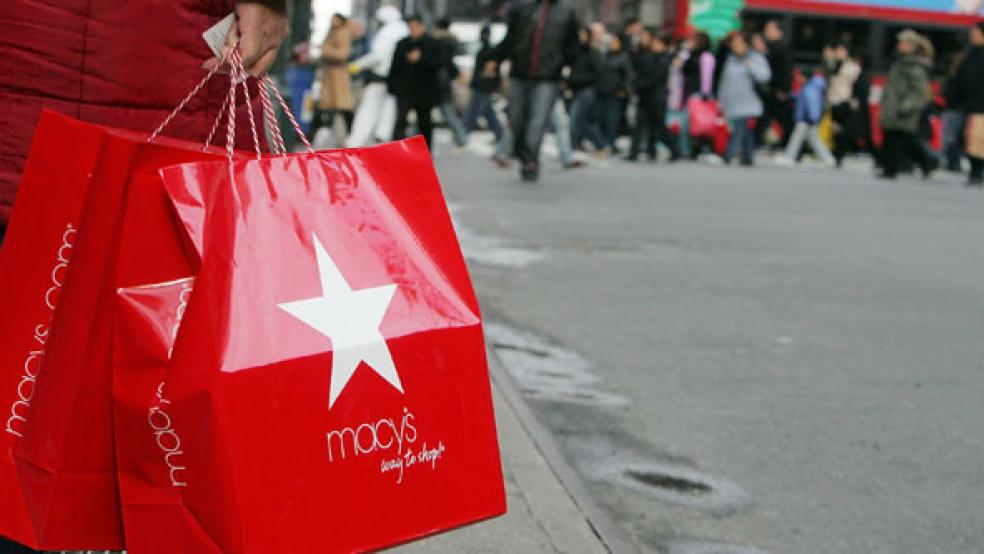December may have been a less-than-jolly month for retail sales, but that doesn’t mean that investors should demand discount valuations from all retail stocks in the same way that they insist on bargains at the mall.
Yes, the retail sales figures released Thursday disappointed economists and investors, especially those hoping for another “pop” like the ones from September and October (up 0.7 percent and 0.5 percent, respectively.) Alas: Despite the annual holiday shopping frenzy, overall retail sales edged up a mere 0.1 percent over November levels (or 0.2 percent, leaving out sales of automobiles), the slowest rate reported since May, as economists and analysts were quick to point out. That compares to economists’ forecasts of a 0.3 percent advance.
The ho-hum results reflect the uncertain outlook for consumers themselves. On the plus side, the unemployment rate is finally falling and consumer confidence is rising. But it will take a lot more job creation and growth in income for those consumers to feel comfortable opening their wallets and spending freely, rather than prowling the stores in quest of 75 percent discounts on cashmere sweaters and electronics.
Still, while the December data may be a worrying sign for those monitoring macro trends in the expectation that they will drive financial markets, it would be foolish for investors to view all retail stocks through the same prism. True, there are some whose performance also disappointed in December. While Best Buy (BBY) CEO Brian Dunn says visits to the electronic retailer’s stores climbed in the fourth quarter, it has been hard for the firm to spin those visits into sales – or at least, into profitable sales. Not surprisingly, the stock trades at a mere 8.15 times trailing 12-month earnings, but the phrase “value trap” springs to mind, especially since sales of electronic products nosedived 3.9 percent in December.
At the other end of the spectrum is Macy’s (M). It should have fared poorly; department stores as a category saw their sales slump 0.8 percent in December. Target (TGT) and J.C. Penney (JCP) were among the numerous losers in this corner of the retail market, posting sales results that didn’t match their own targets. After cutting prices to move merchandise, some of these firms have been slashing their profit forecasts. Keeping stores open from dawn until midnight and offering big bargains just wasn’t enough.
Macy’s, on the other hand, now expects to report that same-store sales grew 5.3 percent to 5.5 percent for the fourth quarter, a full percentage point above an earlier forecast and well above the 3 percent gain the retailer predicted at the beginning of the year. Given that luxury retailers did better than most other categories of retailers – the 1 percent, it seems, are still happy consumers – the upscale Bloomingdale’s division of Macy’s contributed to those gains. But management is sharing the wealth: It doubled its quarterly divided to 10 cents a share last July and just announced plans to do it again, to 20 cents a share to shareholders of record March 15.
Unsurprisingly, investors have responded to this blizzard of good news by driving Macy’s stock price significantly higher in recent months. Last February, the shares changed hands for $22 a share and were hovering around $23 a share as recently as August. Today, the stock is close to $34 a share. But there are still skeptics out there, muttering that the company’s fourth-quarter performance is an anomaly and that there’s a risk that those gains will evaporate in the absence of a significant economic rebound. That’s why the stock still trades at a relatively attractive 12.8 times trailing 12-month earnings, and why analysts have target prices on the stock of as much as $47 a share.
Just as Macy’s proved, by bucking the trend, that not all department stores can be viewed as laggards, so Tiffany (TIF) demonstrates that not all luxury retailers can be counted on to deliver the goods. The company reported poor same-store sales, forcing it to trim its own profit forecasts.
The bottom line is not to make any macro assumptions when it comes to the retailing industry. One firm aimed at middle-class consumers of clothing and footwear – The Gap (GPS) – may be battling to convince customers to buy, even as another – Crocs (CROX) – predicts that sales of its clunky clog-like footwear in a rainbow of colors have been so robust that its revenue is set to top $1 billion for the first time in its history. (Shoe retailers like DSW are doing well, too; DSW recently boosted earnings guidance.)
It might be easier to treat the retailers as if they responded in unison to the same economic trends, but that simply isn’t the case. Doing so means running a twofold risk: losing money as some retailers lag their peers, and losing the opportunity of outperforming the broader market as some companies do an exceptional job and are rewarded for it – even in a lackluster economic environment.






